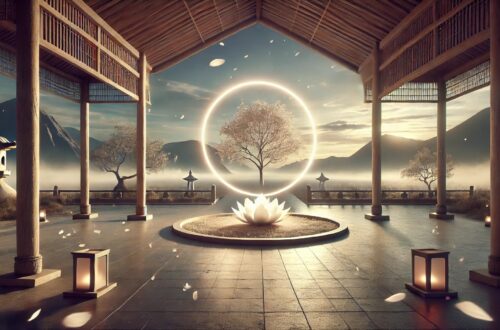The Origination of Three Marks of Dharma

The Origination of Three Marks of Dharma
JUL/01/ 2023—JUL / 02/ 2023
Hello everyone, welcome to our Dharma talk at Dharma Rain Meditation Center.
As is known to all, the Dharma was divided into the worldly Dharmas and transmundane Dharmas. There is a special theory does not belong to the worldly Dharma, which is pratitya-samutpada, we also call it “origin Dharma”. “The pratitya-samutpad” means the cause of origin, which is about equal to the conditions from the worldly Dharma. The Buddhist Dharma believes that everything is made up of karma; everything has an origin. The conditions are complex and fluctuating, so the phenomena of the existence of the universe are also varied and uncertain. Why life is so full of distress and pain because we are fascinated by the phenomena, rise up all kinds of obsessions, and not extricate from the karma. The Buddha realized the well-balanced and inevitable Dharma from the complicated phenomena, that is, “get the wisdom light, give up the obstacle, and all kinds of wisdom will approach.” This is the pratitya-samutpad Dharma.
The pratitya-samutpad Dharma is not created by the Buddha, because no matter Buddha is born or not, the Dharma exists as long as there are life and the material world. The Buddha used his positive wisdom, and keeping in a deep observation, attained the enlightenment to greatly relieve and tell all the well beings. To some extent, the pratitya-samutpad Dharma is indeed the centre of Buddhist teachings. Regardless of the Hinayana or Mahayana, all the theories are explained and developed by this centre. However, it is difficult to understand the inner rationality of the the pratitya-samutpad Dharma. Buddha told his teaching by three aspects for the sentient beings to understand the theory of the pratitya-samutpad Dharma. “Whatever is phenomenal is ephemeral, essential universal Dharma contains no ego-self, Nirvana is “tranquillity, which are the three marks of Dharma.The three marks of Dharma are the three main programs of origin Dharma. To understand the origin Dharma, we have to understand the three marks of Dharma; to understand the three marks of Dharma, we must understand the origin Dharma.
As we all know, a doctrine or a theory must have its inner rationality. We practice Dharma and often talk about origin. Today we are going to talk about the inner rationality of origin Dharma, that is, how the origin Dharma could be the cause of everything.
First, all phenomena arise from causes and conditions; causes and conditions obliterate all phenomena, Therefore, the Dharmas exist in the endless network of karma andpratitya-samutpad. No Dharma can be self-sufficient, independent and always be there. Not only does the Buddha said so, everything we are experiencing also said so.
Second, all the Dharmas arise by causes and conditions; of course, we can not say they have self-nature. Dharma production must rely on the power of many other Dharmas, this Dharma is not the other Dharma that it relies on, but it cannot be left without the other Dharmas. “Do not too distant”, shows that the Dharmas can not be independent and existed alone; “not too familiar” shows that the Dharmas has their own temporary nature. From its inability to be self-sufficient, their self-nature is empty.
Third, the Dharma explains voidness from nature; its original meaning is combine-able, changeable, unreal. We say all Dharma is empty; from the essence, all Dharmas are combine-able, changeable, and unreal. Since those are the characters from their essence that all Dharmas can be dispensable, all Dharmas arise from causes and conditions; causes and conditions obliterate all phenomena. Therefore, “voidness” is a truthful description of the nature of all Dharmas. We can even say that voidness is the reality of all Dharmas.
Fourth, the Dependent Origination and voidness nature are two arguments of one theory; two of them are mutually incompatible and help to explain each other. From the origination, all Dharmas have no self-nature, which means they are empty, but they show up with the illusion of life. This is called “emptiness itself is form”, which is empty however has phenomenon. From the empty nature side, all Dharmas arises and destroyed; they are not more than the phenomenon, the entity does not exist or available. This so-called “Form itself is emptiness”, which seems have something however it is empty in nature. “Empty however has phenomenon” emphasizes the self-nature, so it does not tend to the “existing” side; “have something however it is empty”, empty here does means absolute empty, so it does not tend to the “empty” side neither. Do not tend to either side, that is, tend to the real phase or middle path.
The above has been talked about the internal rationality of the origin Dharma. According to this inner rationality, Buddha taught us three aspects to understand the truth and the pratitya-samutpad Dharma theory. “Whatever is phenomenal is ephemeral, essential universal Dharma contains no ego-self, Nirvana is “tranquillity, which are the three marks of Dharma.
The impermanence of the phenomenons refers to the phase of birth and death in everything. Everything is made up of pratitya-samutpad. Therefore, from the dynamic point, it is born with change and destroyed by the change of pratitya-samutpad. Both birth and distinction are variabilities, so it is impermanent. “Impermanence” is just that permanent is not available, doesn’t mean extinct. We have to know that the origination Dharma is continuous by cause and effect, and there is no end.
Essential universal Dharma contains no ego-self, from the dynamic point, we can see the phenomenons’ impermanence. From a static perspective, the self-sufficiency Dharma is just a name, has no self-nature? “I” is a constant entity, is a real permanence body, “no ego-self” is teaching that denied the Dharma of existence. The Buddha emphasizes the “no ego-self” didn’t mean the phenomenon is empty; he just wanted to clear that the Dharma and phenomenons have no self-nature.
The best way to understand the theory of non-self-ego is to understand the suffering and to observe impermanently. There are many kinds of sufferings, such as the suffering of birth, old age, sickness, death, the suffering of being apart from the loved ones, suffering of being together with the despised ones, suffering of not getting what one wants, suffering of the flourishing of the Five Skandhas etc. No matter which kind of suffering, the Dharma believes that it is caused by impermanence. The phenomenons arise by different causes. Hence it is impermanent, the impermanence means birth and death, gain something and lost; We can not hold our dearest person’s hand forever, we can not make those hateful to die by our curse, we have so many desires because of the Five Skandhas. Everything is constantly changing; what is it true? What is eternal happiness? Therefore, the Buddhist view of suffering is much more thorough than worldly people. The regular people thought the suffering from sorrow and anger, and the Buddhist Dharma find the resource of the problem, pointing that there is suffering if there is impermanence. From the perspective of suffering, we understand a relationship between the cause and the effect, and we cannot decide what happens. “I” contains the meaning of being a master of oneself and freedom. If you the sentient beings are never being their master by themself and never being real free, how can we see ego-self?
Nirvana is silent, the phase of origination from the static words, is no real body, from the dynamic point, are not produced, not destroyed. By observing this movement and two states, we can understand all the Dharmas and phenomenons have no self-nature. If they do not have self-nature, the produce and destroy is just a pseudonym. They are not produced, not destroyed. Therefore, the nature of produce and destroy is not to be immortal; it is equal the impermanence. Therefore, we can understand the impermanence and no ego-self by empty theory and attain the Nirvana.
Thank you for the listening!






4 Comments
Find out more
Thanks for sharing your expertise; I’ve learned a lot from your post.
Laurene
This article spoke to me on a personal level; it hits all the right chords.
Stuart
Your prose flows so effortlessly that I entirely forget of time when perusing your blog.
Jeffrey
Your dedication and enthusiasm shine through in every paragraph. It’s truly remarkable.